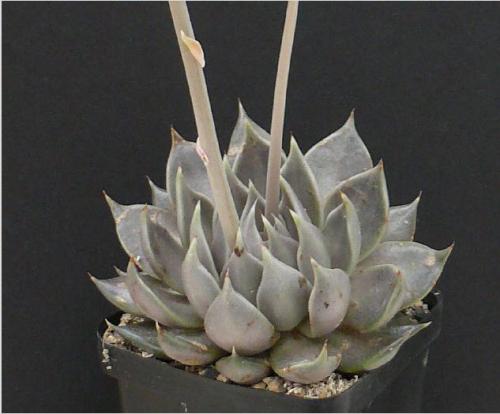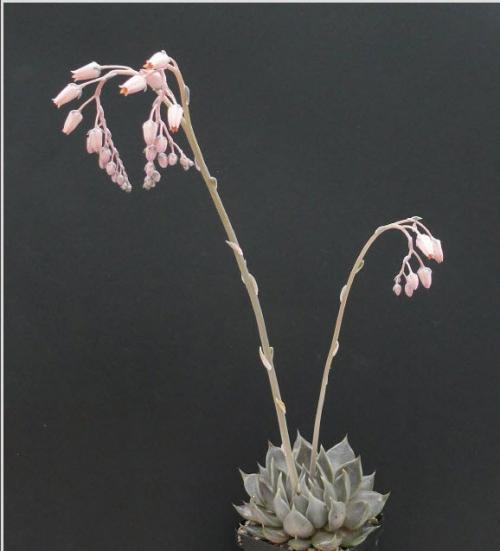TOBARENSIS Berger 1930 (engl./ fr.)
NOT IN CULTIVATION. PROBABLY EXTINCT.
Synonym : Urbinia lurida Rose (1911)
Series Urbiniae
Type : Palmer 248, collected in a "box cañon" near Tobar, Durango, Mexico, May 28, 1906. US 571269.
Etymology : Referring to the locality where the plant had been found.
Distribution : Mexico (Durango)
First Description by Rose as Urbinia lurida in Contributions from the United States National Herbarium 13: 301. 1911 :
Leaves clustered in a dense rosette, very thick, ovate, acuminate, glabrous, purple or lurid in colour, 3 - 4 cm long, 1.5 - 2.5 cm broad at widest point.
Flowering stem 25 cm long, two-branched in only specimen seen.
Stem leaves small, bract-like, scattered.
Flowers : Sepals small, ovate, acute, corolla 6 - 7 mm long, dark red, petals acute, erect except the small outturned tip, carpels distinct to the base.
Note :
Rose wrote : "Type U.S. National herbarium no. 571269, collected by Dr. E. Palmer in a "box cañon" near Tobar, Durango, Mexico, May 28, 1906 (no. 248). Only four specimens were obtained, of which two reached Washington in good condition, one of them flowering April 22, 1908 1. From this the accompanying illustration was made.2 This plant died soon afterwards, while the only remaining plant has not done well and probably will soon disappear. This species is much smaller than any of the other three species of Urbinia 3 and has much more highly colored leaves."
Urbinia lurida / Echeveria tobarensis is
- smaller than E. purpusorum, E. agavoides and E. agavoides 'Corderoyi', i.e. this is a small plant,
- the colour of the leaves is purple and lurid,
- the colour of the flowers is dark red and
- the corolla is only 6 - 7 mm long.
In an article with the misleading title "The rediscovery of the elusive Echeveria tobarensis", published in CSJ US 83(6): 275 - 28. 2011, Etter & Kristen relate that they have found an Echeveria near Tovar and describe it as follows :
Leaves clustered, thick, ovate, sharp acuminate, underside keeled, glabrous, 4 - 6 x 2.5 - 3.5 cm at the widest point, greyish-purple.
Inflorescence 25 - 30 cm long, bifurcate, bracts small and thin, to 1 cm long, regularly spaced.
Flowers : Sepals small, to 5 mm long, ovate, acute, corolla 10 - 12 mm long, petals acute, erect except the small recurved tip, pink.
They believe it to be identical with Urbinia lurida Rose / E. tobarensis Berger - in spite of the fact that it differs from Rose's plant in
- a much bigger rosette,
- greyish instead of purple and lurid leaves,
- flowers twice as long and
- pink instead of dark red.
They argue that Rose’s description has been made from a very poor herbarium specimen and therefore is doubtful, however this is not correct : The above cited annotation by Rose clearly evidences that the description was made from a flowering plant which had been in cultivation in Washington for already two years. Logically a specimen is prepared after a plant had been described. The meanness of the specimen of E. tobarensis is easily explained : Because this plant died soon after its description there was not much left for preparing a specimen.
The fact that the locality of the newly found plant seems not to be very distant from the possible locality where the original plant had been collected is not a sufficient reason to consider it identical with the latter, and in view of the striking differences between the newly found plant and Rose's Urbinia lurida / Echeveria tobarensis Berger it is in no way justified to use the old name for this new and very beautiful plant – it deserves being named properly ! Most likely the original E. tobarensis is extinct.
Link to the French translation.
The newly found plant erroneously considered to be E. tobarensis.
Provisional name Echeveria spec. Tovar :


Photos Gerhard Köhres